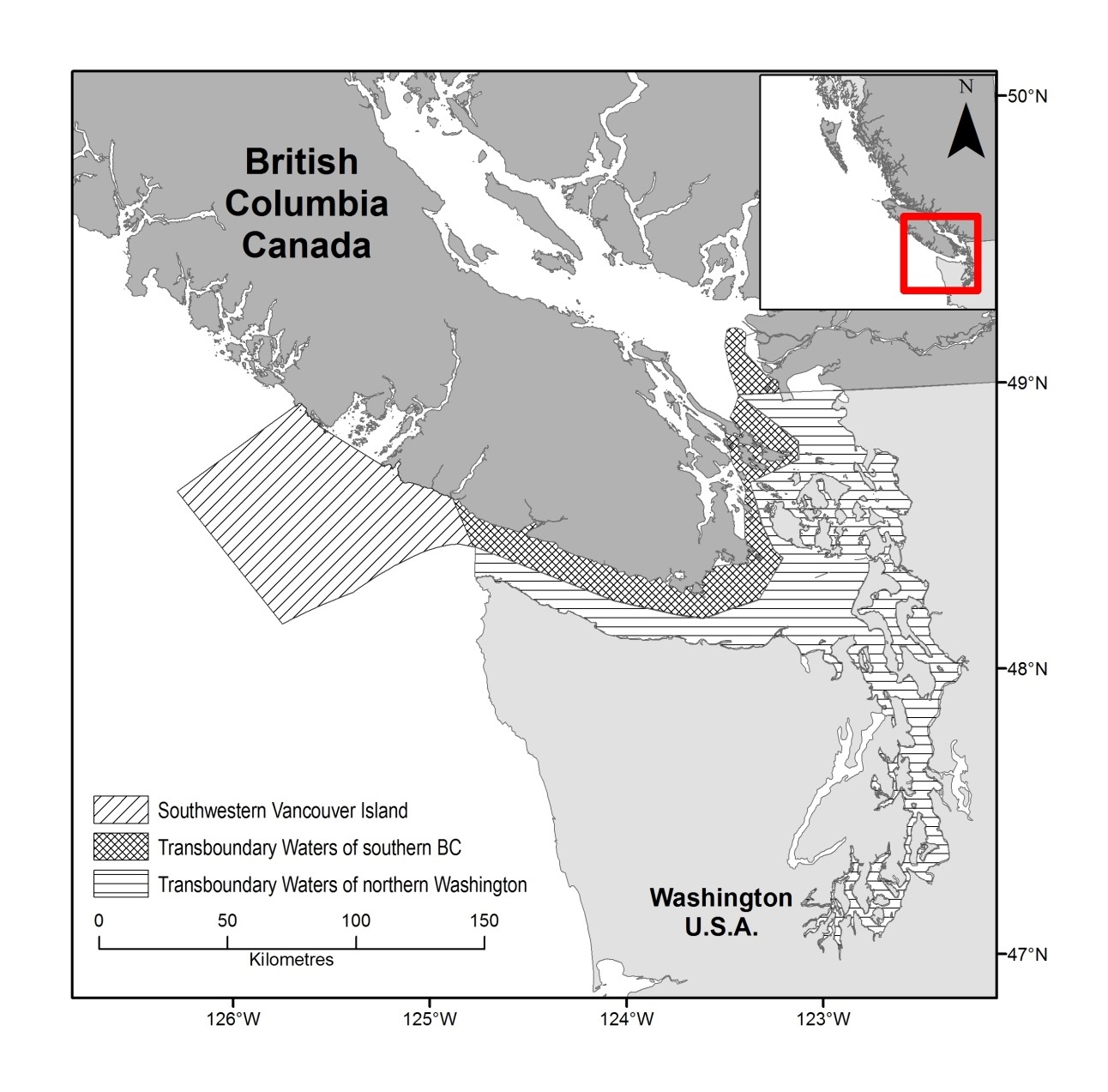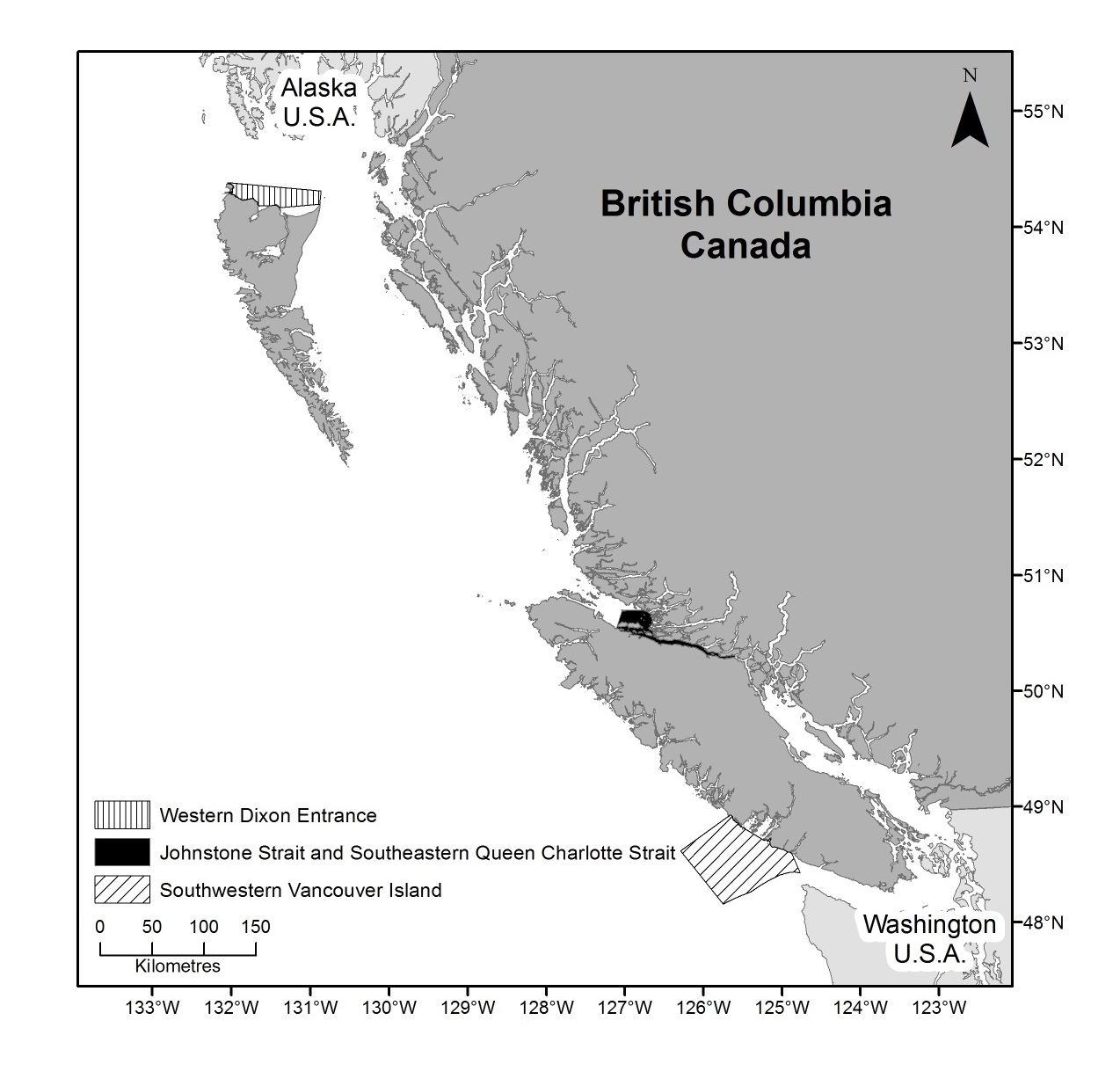Questions and answers: Critical habitat for Northern and Southern Resident Killer Whales in Canada
What is critical habitat?
Critical habitat is defined in the Species at Risk Act (SARA) as the habitat that is necessary for the survival or recovery of a listed wildlife species and that is identified as such in the recovery strategy or action plan for the species. For aquatic species, critical habitat may include areas used for spawning, rearing young, feeding and migration. SARA requires that critical habitat be identified to the extent possible for all endangered, threatened and extirpated species.
What is critical habitat for Northern and Southern Resident Killer Whales?
Partial critical habitat for Northern and Southern Resident Killer Whales was identified in the Recovery Strategy for the Northern and Southern Resident Killer Whales (Orcinus orca) in Canada, which was finalized in 2008 and first amended in 2011. Critical habitat for Southern Resident Killer Whales was identified at that time as the transboundary waters in southern British Columbia, including the southern Strait of Georgia, Haro Strait and Juan de Fuca Strait (Figure 1), while critical habitat for Northern Resident Killer Whales was identified as the waters of Johnstone Strait and southeastern Queen Charlotte Strait (Figure 2).
The 2018 draft Amended Recovery Strategy for the Northern and Southern Resident Killer Whales in Canada was developed to update the critical habitat description (section 7) to clarify the features, functions and attributes of existing critical habitat, and to identify the following areas of special importance as additional proposed critical habitat for Resident Killer Whales:
- Waters on the continental shelf off southwestern Vancouver Island, including Swiftsure and La Pérouse Banks (important for Northern and Southern Resident Killer Whales, Figure 1 and 2); and
- Waters of west Dixon Entrance, along the north coast of Graham Island from Langara to Rose Spit (important for Northern Resident Killer Whales, Figure 2).
According to the best available information on the biological status of the species, this critical habitat provides features, functions and attributes required to support the species’ survival or recovery. For both Northern and Southern Resident Killer Whales, the functions of critical habitat are: feeding and foraging; reproduction; socializing; resting; and additionally for Northern Resident Killer Whales, beach rubbing.
The draft Amended Recovery Strategy for Northern and Southern Resident Killer Whales also provides additional clarification of the features and attributes that applies to the two proposed additional critical habitat areas, as well as to the two critical habitat areas that are already protected. All aquatic habitat in the four areas described above that is characterized by one or more of the following features and attributes is defined as critical habitat for the species:
- Availability of Chinook Salmon, Chum Salmon and other important prey species;
- Acoustic environment;
- Water quality;
- Physical space around whales (200m); and
- For Northern Resident Killer Whales: suitable physical habitat to allow for beach rubbing behaviour.
These features and attributes support the feeding and foraging, reproduction, socializing, resting and beach rubbing functions of Northern and Southern Resident Killer Whale critical habitat.


How is critical habitat legally protected?
Legal protection means that all of the functions, features and attributes of the identified critical habitat are protected from destruction by provision(s) in, or measure(s) under, SARA or another Act of Parliament. Within 180 days after the recovery strategy identifying critical habitat referred to in subsection 58(1) is included in the public registry, the Minister of Fisheries and Oceans and the Minister responsible for the Parks Canada Agency must ensure that the critical habitat is legally protected. Existing critical habitat for Resident Killer Whales in southern BC and in Johnstone and southeastern Queen Charlotte Straits is currently legally protected under a Critical Habitat Order. It is anticipated that the additional critical habitat identified for Resident Killer Whales off southwestern Vancouver Island and in western Dixon Entrance will also be legally protected under a Critical Habitat Order.
Section 58 of SARA prohibits the destruction of any part of the critical habitat identified in documents published in the Species at Risk Public Registry. When in force, this section of SARA:
- Allows charges to be laid under SARA against a person who destroys any part of critical habitat;
- Requires that a permit (or agreement) be obtained before undertaking an activity that is likely to destroy any part of critical habitat, which will contain conditions or restrictions that would reduce the impacts of the activity on the Northern and Southern Resident Killer Whale; and
- Complements existing, applicable laws and regulations by ensuring that all activities that may result in critical habitat destruction are managed as necessary as well as drawing attention to the importance of sites for survival or recovery of the species.
What are the activities likely to destroy critical habitat?
The draft Amended Recovery Strategy provides examples of activities that are likely to destroy any part of critical habitat if unmitigated. These can include single or multiple activities occurring at one point in time or recurrently, that result in immediate or cumulative habitat loss, either temporarily or permanently. Critical habitat destruction would render the area unsuitable to a point where it would no longer serve its function when needed by the species.
The following is a list of examples of activities that are likely to cause destruction of any part of critical habitat found in the draft Amended Recovery Strategy for Northern and Southern Resident Killer Whales if unmitigated. This list is not considered exhaustive but reflects the best available knowledge at this time.
The activities on this list are not automatically prohibited. SARA prohibits the destruction of critical habitat caused by human activities, not the activities themselves. Such destruction may result from activities occurring within or outside of the critical habitat, if they contribute to a critical habitat function being made unavailable at a time it is required by the species.
| Threat | Examples of activities | Possible outcomes |
|---|---|---|
| Reduced prey availability | Fishing for Chinook Salmon, Chum Salmon and other important prey species Other activities detrimental to habitat and survival of prey (e.g. fishing for forage fish species) |
Loss of prey Loss of forage fish for prey species |
| Acoustic disturbance | Vessel traffic Seismic surveys, military and commercial sonars Pile driving, underwater explosions |
Chronic noise resulting in masking of communication and echolocation Acute and chronic acoustic disturbance resulting in disruption of behaviour or displacement from habitat |
| Environmental contaminants | Release of deleterious substances Point source and non-point source pollution |
Loss of prey or reduction in prey quality Loss of water quality |
| Physical disturbance | Vessel approach to whales (within 200m) Vessel anchoring in vicinity of rubbing beaches Activities that prevent approach of whales to rubbing beaches; or that displace or disrupt rubbing behaviour Human presence on rubbing beaches when whales present or nearby |
Reduction of physical space available to whales Displacement of whales from rubbing beaches, prevention of use of rubbing beaches |
| Geophysical disturbance | Shore-based industrial activities that could alter beach substrate Activities that result in alteration of stream flow to rubbing beaches, beach sediment and siltation |
Geophysical disturbance resulting in loss of function |
How do I ensure my activities will not destroy Critical Habitat?
The draft Amended Recovery Strategy for the Northern and Southern Resident Killer Whale contains information that may help you determine if your activity could destroy any part of critical habitat. If you are still uncertain, seek advice from a qualified environmental professional. They may be able to advise you on how to proceed with your activity while also protecting Northern and Southern Resident Killer Whale critical habitat by providing technical advice on appropriate measures to avoid or mitigate impacts. If your activity could destroy any part of critical habitat for Northern and Southern Resident Killer Whales, you will need to contact DFO to determine if the activity can be authorized.
Who do I contact for more information?
For more information, please contact: SARA.XPAC@dfo-mpo.gc.ca
- Date modified: